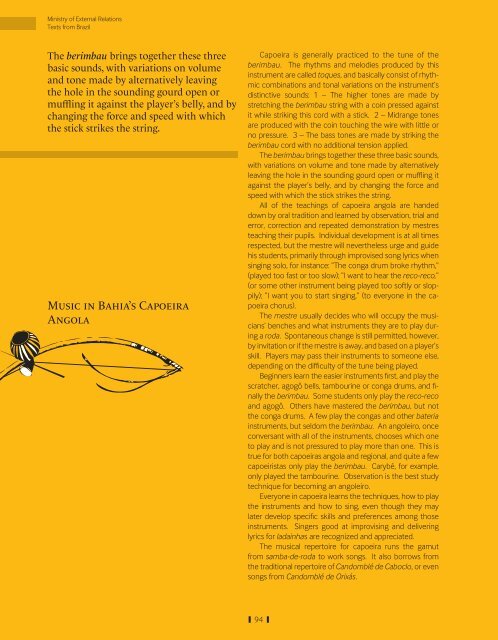Music in Bahia's Capoeira Angola - the Embassy of Brazil
Music in Bahia's Capoeira Angola - the Embassy of Brazil
Music in Bahia's Capoeira Angola - the Embassy of Brazil
Create successful ePaper yourself
Turn your PDF publications into a flip-book with our unique Google optimized e-Paper software.
M<strong>in</strong>istry <strong>of</strong> External Relations<br />
Texts from <strong>Brazil</strong><br />
The berimbau br<strong>in</strong>gs toge<strong>the</strong>r <strong>the</strong>se three<br />
basic sounds, with variations on volume<br />
and tone made by alternatively leav<strong>in</strong>g<br />
<strong>the</strong> hole <strong>in</strong> <strong>the</strong> sound<strong>in</strong>g gourd open or<br />
muffl <strong>in</strong>g it aga<strong>in</strong>st <strong>the</strong> player’s belly, and by<br />
chang<strong>in</strong>g <strong>the</strong> force and speed with which<br />
<strong>the</strong> stick strikes <strong>the</strong> str<strong>in</strong>g.<br />
<strong>Music</strong> <strong>in</strong> Bahia’s <strong>Capoeira</strong><br />
<strong>Angola</strong><br />
<strong>Capoeira</strong> is generally practiced to <strong>the</strong> tune <strong>of</strong> <strong>the</strong><br />
berimbau. The rhythms and melodies produced by this<br />
<strong>in</strong>strument are called toques, and basically consist <strong>of</strong> rhythmic<br />
comb<strong>in</strong>ations and tonal variations on <strong>the</strong> <strong>in</strong>strument’s<br />
dist<strong>in</strong>ctive sounds: 1 – The higher tones are made by<br />
stretch<strong>in</strong>g <strong>the</strong> berimbau str<strong>in</strong>g with a co<strong>in</strong> pressed aga<strong>in</strong>st<br />
it while strik<strong>in</strong>g this cord with a stick. 2 – Midrange tones<br />
are produced with <strong>the</strong> co<strong>in</strong> touch<strong>in</strong>g <strong>the</strong> wire with little or<br />
no pressure. 3 – The bass tones are made by strik<strong>in</strong>g <strong>the</strong><br />
berimbau cord with no additional tension applied.<br />
The berimbau br<strong>in</strong>gs toge<strong>the</strong>r <strong>the</strong>se three basic sounds,<br />
with variations on volume and tone made by alternatively<br />
leav<strong>in</strong>g <strong>the</strong> hole <strong>in</strong> <strong>the</strong> sound<strong>in</strong>g gourd open or muffl <strong>in</strong>g it<br />
aga<strong>in</strong>st <strong>the</strong> player’s belly, and by chang<strong>in</strong>g <strong>the</strong> force and<br />
speed with which <strong>the</strong> stick strikes <strong>the</strong> str<strong>in</strong>g.<br />
All <strong>of</strong> <strong>the</strong> teach<strong>in</strong>gs <strong>of</strong> capoeira angola are handed<br />
down by oral tradition and learned by observation, trial and<br />
error, correction and repeated demonstration by mestres<br />
teach<strong>in</strong>g <strong>the</strong>ir pupils. Individual development is at all times<br />
respected, but <strong>the</strong> mestre will never<strong>the</strong>less urge and guide<br />
his students, primarily through improvised song lyrics when<br />
s<strong>in</strong>g<strong>in</strong>g solo, for <strong>in</strong>stance: “The conga drum broke rhythm,”<br />
(played too fast or too slow); “I want to hear <strong>the</strong> reco-reco,”<br />
(or some o<strong>the</strong>r <strong>in</strong>strument be<strong>in</strong>g played too s<strong>of</strong>tly or sloppily);<br />
“I want you to start s<strong>in</strong>g<strong>in</strong>g,” (to everyone <strong>in</strong> <strong>the</strong> capoeira<br />
chorus).<br />
The mestre usually decides who will occupy <strong>the</strong> musicians’<br />
benches and what <strong>in</strong>struments <strong>the</strong>y are to play dur<strong>in</strong>g<br />
a roda. Spontaneous change is still permitted, however,<br />
by <strong>in</strong>vitation or if <strong>the</strong> mestre is away, and based on a player’s<br />
skill. Players may pass <strong>the</strong>ir <strong>in</strong>struments to someone else,<br />
depend<strong>in</strong>g on <strong>the</strong> diffi culty <strong>of</strong> <strong>the</strong> tune be<strong>in</strong>g played.<br />
Beg<strong>in</strong>ners learn <strong>the</strong> easier <strong>in</strong>struments fi rst, and play <strong>the</strong><br />
scratcher, agogô bells, tambour<strong>in</strong>e or conga drums, and fi -<br />
nally <strong>the</strong> berimbau. Some students only play <strong>the</strong> reco-reco<br />
and agogô. O<strong>the</strong>rs have mastered <strong>the</strong> berimbau, but not<br />
<strong>the</strong> conga drums. A few play <strong>the</strong> congas and o<strong>the</strong>r bateria<br />
<strong>in</strong>struments, but seldom <strong>the</strong> berimbau. An angoleiro, once<br />
conversant with all <strong>of</strong> <strong>the</strong> <strong>in</strong>struments, chooses which one<br />
to play and is not pressured to play more than one. This is<br />
true for both capoeiras angola and regional, and quite a few<br />
capoeiristas only play <strong>the</strong> berimbau. Carybé, for example,<br />
only played <strong>the</strong> tambour<strong>in</strong>e. Observation is <strong>the</strong> best study<br />
technique for becom<strong>in</strong>g an angoleiro.<br />
Everyone <strong>in</strong> capoeira learns <strong>the</strong> techniques, how to play<br />
<strong>the</strong> <strong>in</strong>struments and how to s<strong>in</strong>g, even though <strong>the</strong>y may<br />
later develop specifi c skills and preferences among those<br />
<strong>in</strong>struments. S<strong>in</strong>gers good at improvis<strong>in</strong>g and deliver<strong>in</strong>g<br />
lyrics for lada<strong>in</strong>has are recognized and appreciated.<br />
The musical repertoire for capoeira runs <strong>the</strong> gamut<br />
from samba-de-roda to work songs. It also borrows from<br />
<strong>the</strong> traditional repertoire <strong>of</strong> Candomblé de Caboclo, or even<br />
songs from Candomblé de Orixás.<br />
94



